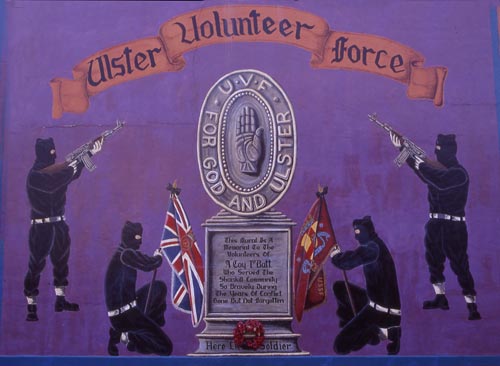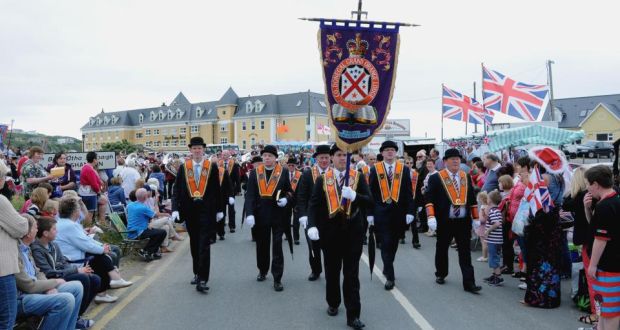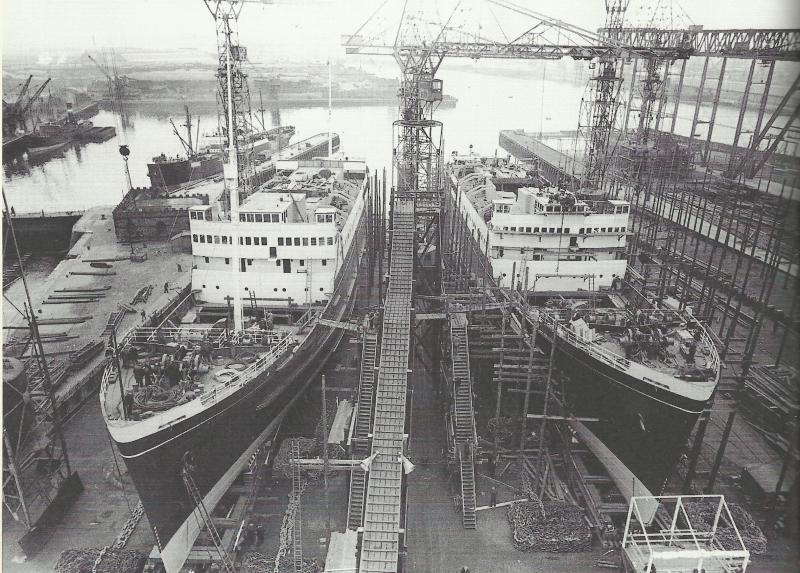IRISH HISTORY SINCE 1850
2. An Gorta Mór
3. The Land League
4. Parnell and Home Rule
5. Unionism
6. The Cultural Revival
7. Home Rule
8. The Easter Rebellion
9. The War of Independence
10. The Free State: '20s
11. The Free State: '30s
12. The Troubles: '60s & '70s
13. The Troubles: '80s & '90s
14. The Celtic Tiger
15. Death of the Tiger
16. Sources
Unionism
While the campaigns of the Land League, the Fenians, and Parnell were all well and good if you were a small Catholic farmer — after all, they were battling for you — many in Ireland didn't share this enthusiasm. A large proportion of people in Ireland, especially in Ulster, didn't want any form of Home Rule; they wanted Ireland to stay part of the British state. Such people, the unionists, were backed by powerful interests in business, land ownership, the Protestant Church, and the Orange Order. They wouldn't take Home Rule lying down. During the last decades of the nineteenth century they began organizing and campaigning to ensure that Ireland, or at least some part of it, would always remain British.
The unionists believed that Ireland was theirs (and for many, it had been since the plantations) and an integral part of Britain and the Empire. They didn't want Home Rule, and they certainly didn't want to be included in a state where the majority of people were Catholics. They were often well-off or, if they were workers, believed that industrial stability came from the link with Britain. Unionists were contented precisely because of Britain and its Empire, so why change? If Ireland left the union, what would happen to their wealth, influence, and power?
Deciding that there was little in the idea of Home Rule that appealed to them, the unionists took matters into their own hands and set out to oppose Home Rule by whatever means possible. At an anti-Home Rule meeting in Belfast one opponent of Home Rule stated that "Ulster will fight, and Ulster will be right." That pretty much summed up what the unionists felt about the whole situation.
In the decades leading to the turn of the century the unionists started getting organized. In 1867 the Ulster Defence Association and the Central Protestant Defence Association were formed by elite unionists to fight any moves towards Home Rule. These were followed by the Ulster Loyalist Anti-Repeal Association, the Ulster Defence Union, and many local Unionist Clubs.

celebrating the Ulster Volunteer Force
By 1912, when the Liberal government was again backing Home Rule, over 400,000 unionists came together in Belfast to sign the Solemn League and Covenant, which pledged them to "use all means necessary to defeat the present conspiracy to set up a Home Rule Parliament in Ireland." In 1913, things really came to a head, when the Ulster Volunteer Force, with 100,000 men and 20,000 rifles, prepared to fight, if necessary, against Home Rule. The message was simple: while the majority of Ireland might want its freedom, and the Liberals, for their own domestic purposes might be happy to give it to them, unionists would fight. The black clouds were gathering.
The Ulster Volunteer Force continued to demonstrate its loyalty to Britain during the First World War when a substantial proportion of the organization enlisted to form the predominantly unionist and almost wholly Protestant 36th (Ulster) Division. The Division was decimated on the first day of the Battle of the Somme in 1916 and became a potent symbol of the sacrifices made by unionists in defense of the Union. In 1966 the name, the Ulster Volunteer Force re-emerged to defend Ulster, and became one of the most notorious Loyalist paramilitary organizations responsible for scores of murders.
The most important motivation for the unionists, and their most powerful tool, was religion. They feared enough from Home Rule in terms of economics and politics to motivate them, but what really got them upset was the link between Irish nationalism and Catholicism. Unionists were not only loyal to Britain, but absolutely wedded to their own religion: Protestantism. The trouble really began before the first Home Rule Act had been introduced in 1886. In an attempt to make everyone happy in Ireland and head off more serious demands for reform, Gladstone had passed an Irish Church Act in 1869. For the Catholics the act looked like an equalization of the rights of worship in Ireland. To unionists, the act resembled only one thing: the disestablishment of the (Protestant) Church of Ireland. To unionists the Irish Church Act proved to them that their way of life was under threat. All the first Home Rule Act did was underpin their belief.
To combat the attack on their way of life and the threat from home rule, the unionists turned to the Orange Order. The Order, as one historian summed up, "provided the only credible basis for loyalist opposition to both the Land League and the National League." The Orange Order brought together politically-minded unionists with members of the Church of Ireland and Presbyterians, all of whom felt threatened by an aggressive Catholicism with political goals. What the Orange Order did, with great effectiveness, was link together all strands of unionist life. It was an organization that was run by the social elites, but included and welcomed members from all social levels. The Order offered a potent mix of politics, religion, and ritual which translated the unionist campaign against Home Rule and the Land League from one that was merely political, into one that was underpinned by a religious sense of righteousness. It would be an organization that would dominate the agenda of unionism and be a central force in the mobilization of Protestant opinion from the late nineteenth century to modern times. Crucially, it linked the survival of unionism with the power of a non-Catholic God. If Irish politics weren't complicated enough, the Order brought religion fully and publicly into the equation.

The Orange Order was popular in the late nineteenth century and has lost none of its vigor. The movement is still important in unionist politics in Northern Ireland, and publicly declares its allegiance to Britain and the Crown on July 12 every year by marching to celebrate the victory of Protestant King William over Catholic King James at the Battle of the Boyne.
The Orange Order and the unionists weren't just concerned about their political and religious freedoms; they also believed that Home Rule would make them poorer. Belfast was at the heart of the British industrial success in the second half of the nineteenth century. During the American Civil War, and the resultant downturn in cotton exports to the UK, linen came into its own. And where was the linen industry? Belfast. By 1894, the amount of linen thread produced in Belfast would have circled the earth a staggering 25,000 times, a rate of production making many people rich along the way. At the same time the railways delivered raw materials and finished goods from Ulster's towns and cities, to the docks that would allow their rapid and cheap transport to the British market. Ulster was booming.
Shipbuilding was one of the core industries in Belfast. In the 1890s, the Belfast yards made more ships than anyone else. Engineering industries grew up that supported the shipyards and all these added to the wealth and skill base in Ulster. They also turned themselves to more self-indulgent products — Belfast became the largest producer of aerated water, made 60% of Ireland's whiskey and at Gallagaher's made cigarettes for the whole of Ireland and Britain. It might have been a dirty and noisy city, but it was one of the great Victorian industrial success stories. The high levels of income and work that were available in Ulster made unionists even more wary of the Home Rulers — if Ireland left the Union, would their profits be threatened?

The unionists were enthusiastic supporters of the Empire, and their political beliefs were as vociferous in their support of the imperial idea as they were in their belief in State and Crown. They, like the British, were opposed to Home Rule in Ireland because of the impact separation would have on the rest of the Empire. The British felt that if Ireland, a landmass that was so close to Britain, could challenge British rule, this might encourage other colonial nations to also try and leave the club. The British were especially worried about the behavior of separatists in South Africa (the British were fighting a war against the nationalist Boers at the time) and India. If the Irish got what they wanted, who knows what might happen? Also worrying the British was the widespread and vocal support for the Boer cause across Ireland, fearing that it could indicate an emerging union between the oppressed people of Empire.